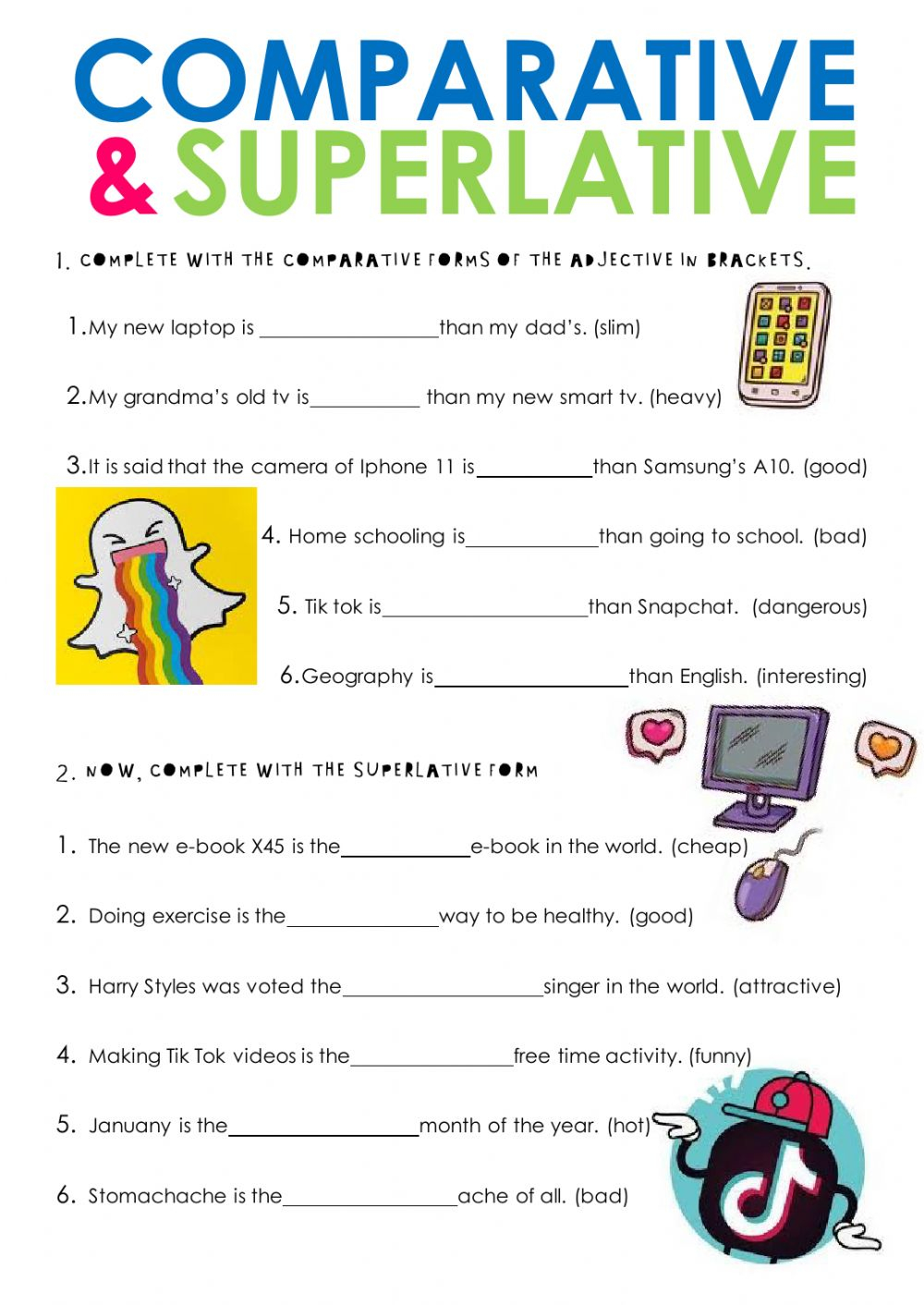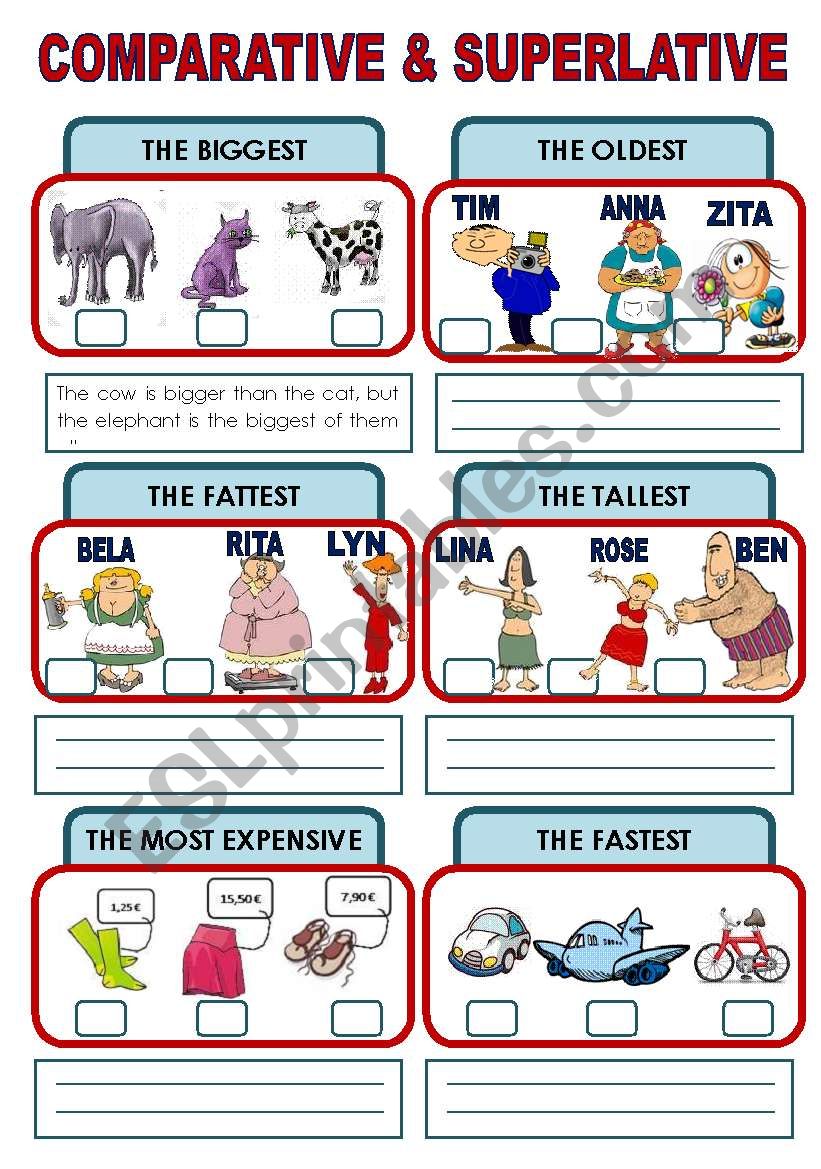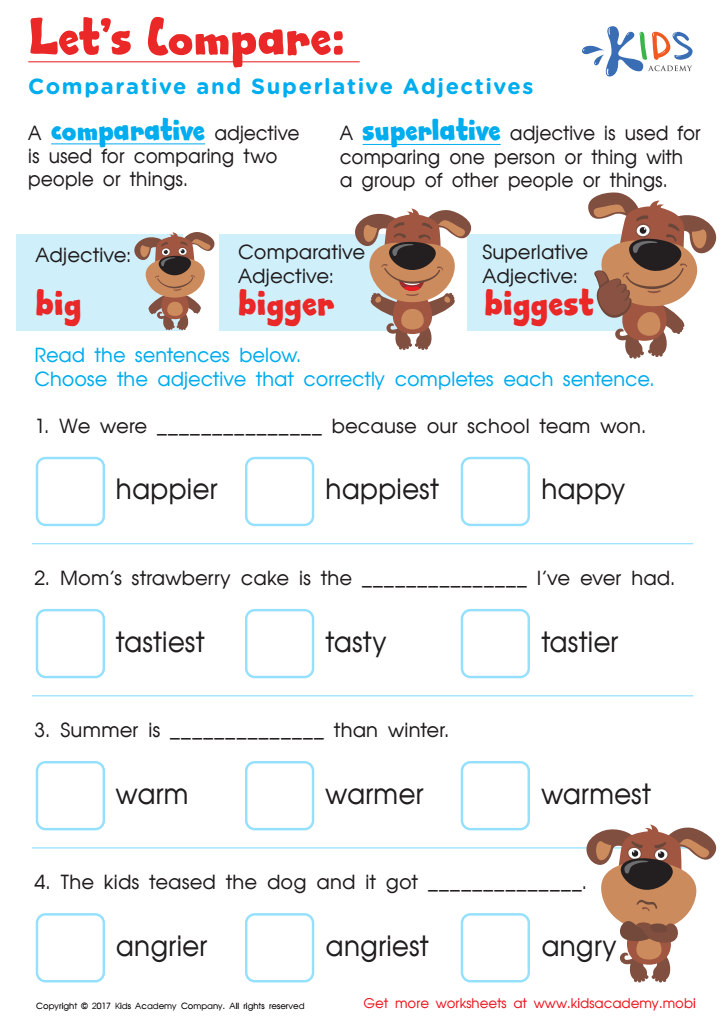
Mastering Comparisons: The Indispensable Role of Comparative and Superlative A1 Worksheets
English, a global language, offers a fascinating journey of linguistic exploration. For beginners, often categorized under the A1 level according to the Common European Framework of Reference for Languages (CEFR), the initial steps are crucial for building a strong foundation. Among the foundational grammar points, comparatives and superlatives stand out as essential tools for describing the world around us, allowing learners to articulate differences and extremes. And for effective acquisition at this fundamental stage, comparative and superlative A1 worksheets play an indispensable role.
This article delves into why these worksheets are so vital, what makes them effective, and how they can be best utilized to ensure A1 learners confidently grasp the nuances of comparing and contrasting.
The A1 Learner: A Foundation in the Making

The A1 level, often referred to as a "Breakthrough" or "Beginner" level, signifies a learner’s ability to understand and use very basic everyday expressions and phrases. They can introduce themselves, ask and answer simple questions about personal details, and interact in a simple way provided the other person speaks slowly and clearly.

At this stage, the focus is on building core vocabulary and understanding fundamental sentence structures. Introducing concepts like comparatives (e.g., "bigger," "more interesting") and superlatives (e.g., "the biggest," "the most interesting") empowers A1 learners to move beyond simple descriptions ("The house is big") to more nuanced observations ("The house is bigger than the flat," "This is the biggest house on the street"). This ability to compare and contrast is fundamental to everyday communication and cognitive development within a new language.

Why Worksheets Are Essential for A1 Grammar Acquisition

While interactive games, songs, and real-life conversations are invaluable, worksheets provide a structured, tangible, and repeatable method for grammar practice. For A1 learners, who are often still developing their literacy skills in English, worksheets offer:

- Focused Practice: They isolate specific grammar points, allowing learners to concentrate solely on forming comparatives and superlatives without the pressure of spontaneous conversation.
- Reinforcement: Repetition is key for memory retention. Worksheets provide ample opportunities to repeatedly apply the rules of comparative and superlative formation.
- Visual Learning: Many A1 worksheets incorporate images, making abstract grammatical concepts more concrete and accessible, especially for visual learners.
- Self-Paced Learning: Learners can work through exercises at their own speed, revisiting difficult sections as needed. This fosters independence and reduces anxiety.
- Measurable Progress: Completing a worksheet provides a clear sense of accomplishment and allows both learners and teachers to identify areas that need more attention.
- Teacher Resource: Worksheets are a ready-made resource for teachers, saving preparation time and providing a consistent framework for instruction.


This is precisely where comparative and superlative A1 worksheets shine, offering targeted practice that solidifies understanding.

Core Concepts for A1: A Brief Grammar Refresher
Before diving into worksheet types, it’s helpful to briefly review the comparative and superlative forms typically introduced at the A1 level:

-
Comparatives (Comparing two things):
- Short adjectives (1 syllable): Add "-er" (e.g., tall -> taller, fast -> faster).
- Adjectives ending in -e: Add "-r" (e.g., large -> larger).
- Adjectives ending in consonant + vowel + consonant: Double the last consonant and add "-er" (e.g., big -> bigger, hot -> hotter).
- Adjectives ending in -y: Change -y to -i and add "-er" (e.g., happy -> happier, easy -> easier).
- Longer adjectives (2+ syllables): Use "more" before the adjective (e.g., beautiful -> more beautiful, interesting -> more interesting).
- Irregular forms: Good -> better, bad -> worse.
- Structure: Noun 1 + verb + comparative adjective + than + Noun 2. (e.g., "The cat is smaller than the dog.")
-
Superlatives (Comparing three or more things, identifying the extreme):
- Short adjectives (1 syllable): Add "the" and "-est" (e.g., tall -> the tallest, fast -> the fastest).
- Adjectives ending in -e: Add "the" and "-st" (e.g., large -> the largest).
- Adjectives ending in consonant + vowel + consonant: Double the last consonant and add "the" and "-est" (e.g., big -> the biggest, hot -> the hottest).
- Adjectives ending in -y: Change -y to -i and add "the" and "-est" (e.g., happy -> the happiest, easy -> the easiest).
- Longer adjectives (2+ syllables): Use "the most" before the adjective (e.g., beautiful -> the most beautiful, interesting -> the most interesting).
- Irregular forms: Good -> the best, bad -> the worst.
- Structure: Noun + verb + the superlative adjective + (in/of a group). (e.g., "She is the tallest in the class.")
A1 worksheets will typically focus on the most common regular forms and perhaps the very common irregulars like "good/better/best."
Types of Effective Comparative and Superlative A1 Worksheets
To cater to diverse learning styles and ensure comprehensive understanding, a variety of worksheet types should be employed:
-
Fill-in-the-Blanks:
- Description: These are perhaps the most common and straightforward. Sentences are provided with a blank space where the learner needs to insert the correct comparative or superlative form of a given adjective.
- Example: "My brother is (tall) than me." or "Mount Everest is (high) mountain in the world."
- Benefit: Excellent for practicing the morphological changes (adding -er/-est, more/most) and remembering the "than" and "the" articles.
-
Matching Exercises:
- Description: Learners match base adjectives with their correct comparative and superlative forms, or match sentences with appropriate comparative/superlative phrases.
- Example: Column A: "small," "happy," "expensive" | Column B: "the happiest," "smaller," "more expensive," "the smallest," "happier," "the most expensive."
- Benefit: Reinforces recognition of the different forms and builds vocabulary.
-
Picture-Based Comparisons:
- Description: Worksheets feature two or three pictures (e.g., different sized animals, buildings, or objects) and prompt learners to write sentences comparing or describing the superlative using the provided visuals.
- Example: Pictures of a small mouse, a medium-sized cat, and a large elephant. Prompts: "The mouse is (small) than the cat." "The elephant is (big) animal."
- Benefit: Highly engaging for visual learners, connects grammar to real-world objects, and encourages sentence formation.
-
Sentence Transformation:
- Description: Learners are given a simple sentence and asked to rewrite it using a comparative or superlative.
- Example: "The red car is fast. The blue car is faster." (Rewrite using comparative). "London is a big city. Tokyo is a big city. New York is a big city." (Rewrite using superlative for New York).
- Benefit: Develops flexibility in sentence structure and encourages deeper understanding of meaning.
-
Error Correction:
- Description: Sentences are presented with common errors in comparative or superlative usage, and learners must identify and correct them.
- Example: "My dog is more bigger than your dog." (Correction: "My dog is bigger than your dog.") or "She is best student in class." (Correction: "She is the best student in class.")
- Benefit: Promotes critical thinking and helps learners internalize correct usage by recognizing common mistakes.
-
Personalized Comparisons:
- Description: Worksheets ask learners to compare things from their own lives (family members, friends, possessions, places they know).
- Example: "Write sentences comparing two members of your family (e.g., ‘My sister is taller than me.’)." "What is the (beautiful) ____ place you know?"
- Benefit: Makes learning highly relevant and motivating, connecting grammar to personal experience, and encourages self-expression.
-
Simple Dialogue/Short Passage Completion:
- Description: A short dialogue or passage is provided with blanks for comparative/superlative forms, or learners might write a short descriptive paragraph using these forms.
- Benefit: Integrates grammar into a communicative context, preparing learners for more natural language use.
The variety offered by comparative and superlative A1 worksheets ensures that learners approach the grammar point from multiple angles, reinforcing their understanding.
Designing and Selecting Effective A1 Worksheets
When creating or choosing comparative and superlative A1 worksheets, consider the following principles:
- Clarity and Simplicity: Instructions must be extremely clear and use vocabulary accessible to A1 learners.
- Appropriate Vocabulary: Ensure the adjectives used are within the A1 vocabulary range (e.g., big, small, fast, slow, happy, sad, old, new, short, long, good, bad).
- Gradual Difficulty: Start with very simple forms (e.g., 1-syllable adjectives) before moving to longer adjectives or irregulars.
- Visual Appeal: Use clear fonts, ample white space, and engaging (but not distracting) images.
- Answer Keys: For self-study or quick teacher checks, an answer key is invaluable.
- Contextualization: Even simple sentences should try to provide a minimal context to make the practice more meaningful.
- Repetition with Variation: Provide enough practice, but vary the exercise types to keep learners engaged.
Integrating Worksheets into the Learning Process
Worksheets are most effective when integrated into a broader lesson plan:
- Introduction (Concept Explanation): Begin by introducing comparatives and superlatives using realia, pictures, or simple examples on the board. Make the concept clear and interactive.
- Guided Practice (Worksheet 1): Work through the first worksheet together as a class or in small groups. This allows the teacher to clarify doubts and provide immediate feedback.
- Independent Practice (Worksheet 2): Learners complete a second worksheet individually. This is where they apply what they’ve learned independently.
- Review and Feedback: Go over the answers, discussing common errors and reinforcing correct usage.
- Extension Activities: Follow up with speaking activities (e.g., comparing students in the class, family members, or objects in the room), simple writing tasks, or games that utilize the grammar point.
- Homework: Assign additional worksheets for homework to reinforce learning outside the classroom.
Common Pitfalls and How Worksheets Can Help
A1 learners often encounter specific challenges with comparatives and superlatives:
- Forgetting "the" with superlatives: Worksheets that require explicit insertion of "the" (e.g., fill-in-the-blanks) can drill this crucial article.
- Confusing "-er" with "more" / "-est" with "most": Varied practice with both short and long adjectives helps learners differentiate when to use which form.
- Spelling Rules (doubling consonants, changing -y to -i): Worksheets specifically focusing on these spelling changes (e.g., "big -> bigger," "happy -> happier") are vital.
- Irregular Forms: Dedicated practice for "good/better/best" and "bad/worse/worst" is essential.
- Over-generalization: Learners might try to apply "-er/-est" to all adjectives. Error correction exercises can highlight these over-generalizations.
By targeting these common pitfalls directly, well-designed comparative and superlative A1 worksheets can significantly improve accuracy.
Beyond the Page: Connecting Worksheets to Real-Life
While worksheets are excellent for structured practice, always aim to connect them to real-life communication. Encourage learners to:
- Describe their family: "My dad is older than my mom."
- Compare their possessions: "My phone is newer than your phone."
- Talk about their favorite things: "Pizza is the most delicious food."
- Play simple comparison games: "Who is taller, A or B?" "What is the biggest animal in the zoo?"
This integration ensures that the grammar learned through comparative and superlative A1 worksheets becomes a functional part of their language toolkit.
Conclusion
The journey of learning a new language is built step by step, and for A1 English learners, mastering comparatives and superlatives is a significant stride. Comparative and superlative A1 worksheets serve as a fundamental building block in this process, offering structured, engaging, and repeatable practice that solidifies grammatical understanding and boosts confidence. By selecting diverse, well-designed worksheets and integrating them thoughtfully into a comprehensive learning strategy, educators and parents can empower A1 learners to describe, differentiate, and express themselves with greater accuracy and fluency, setting them on a path towards more complex linguistic achievements.
